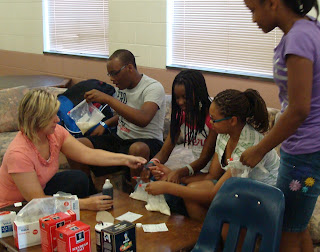Fall afterschool programming is underway at VMNH and middle school students are busily testing myths! Loosely based on the popular tv show, MythBusters, students are challenged to design ways to test commonly held ideas. Students worked with a partner to write out their procedure and design experiments to test each myth.
Tested myths include:
Tested myths include:
1. When dropped, a piece of bread will always land peanut butter side down.
2. Which has the most germs? Students were asked to list the area in their location with the most amount of germs (i.e. the gym floor). Based on their answer, students swabbed that particular area with q tips and then swabbed agar plates to observe the bacteria/mold that was generated. The agar plates germinated for several days and students were able to view their results. Students tested the gym floor, toilet, urinal, telephone, restroom sink and restroom floor. The telephone was the winner! (Gross!!)
2. Which has the most germs? Students were asked to list the area in their location with the most amount of germs (i.e. the gym floor). Based on their answer, students swabbed that particular area with q tips and then swabbed agar plates to observe the bacteria/mold that was generated. The agar plates germinated for several days and students were able to view their results. Students tested the gym floor, toilet, urinal, telephone, restroom sink and restroom floor. The telephone was the winner! (Gross!!)
 |
| Student collecting bacteria from a toilet. |
 |
| Students swabbing their agar plates. |
 |
| Two students testing to see if the peanut butter side of a piece of toast will always land peanut butter side down. |
















